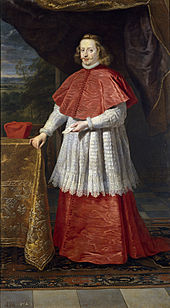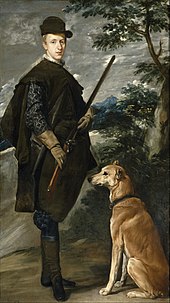Ferdinand of Spain



Ferdinand of Spain and Portugal (Spanish: Fernando de Austria) (born May 16, 1609 or May 24, 1610 in the Escorial near Madrid ; † November 9, 1641 in Brussels ) was a prince from the Spanish line of the House of Habsburg ( Casa de Austria ) and served as governor of Spanish possessions and as general in the Thirty Years War . Because of his appointment as Cardinal Archbishop of Toledo, he is also known as Cardinal Infante Ferdinand .
Life
Ferdinand was the third son of King Philip III. born of Spain on May 16, 1609. In 1619 he received the permanent administration of the Archdiocese of Toledo and soon afterwards the cardinal's hat . The cardinalate for the king's son was also the result of an intrigue at the royal court. The politically endangered Minister Duque de Lerma had brought himself up for a cardinal's hat. Political factions at the royal court that had no interest in such a rise of the minister therefore brought the later son of the king into play. According to his origins, he should have received Toledo as the most respected diocese with the cardinal's hat. As a side effect, its income would have directly benefited the crown. Pope Paul V initially played for a time, as the appointment of the young king's son was not compatible with canon law. A papal dispensation was required for this. On the other hand, Pope Paul V was definitely interested in signing the Spanish royal family. He wished to be awarded the grandeza , the highest Spanish nobility class for the ancestor of his Borghese family . The family, which came from the Sienese patriciate , wanted to achieve the rise in the Roman nobility in this way. On March 11, 1619, the king's son was awarded the title of cardinal. Fernando was the first cardinal of royal blood in Spanish history. After the dispensation was granted on March 1, 1620, Fernando was able to become Archbishop of Toledo. In December 1620, the prospect of the Borghese family was raised.
In 1633 he was supposed to come to the aid of the emperor in Germany with an army, but initially only sent a partial army from Italy under the command of the Duke of Feria , which united with a Bavarian league army at Ravensburg at the end of September and after some heavy fighting in southern Germany took winter quarters in Munich. He himself continued to recruit soldiers in northern Italy at various locations and pacified an old dispute between the Genoese and the Duke of Savoy .
With the army he set up, he moved across the Alps and Innsbruck to Munich, where he incorporated the remnants of the Feria army into his army. In September 1634 he united this army with an Imperial Bavarian army under the command of his cousin, the son of Emperor Ferdinand II , the then King of Hungary and later Emperor Ferdinand III. Together with him he commanded the entire army in the battle of Nördlingen . Then he turned to the Netherlands in April 1635 . Here he knew how to stop the progress of the overpowering French-Dutch army through a small war , crossed the French border in June 1636, forced La Capelle to surrender, penetrated victoriously to Corbie , but had to withdraw again after losing several permanent places.
In 1637 he tried in vain to relieve Breda, which was besieged by the Prince of Orange . On June 22, 1638, on the other hand, he achieved the brilliant victory at Calloo over Count Wilhelm von Nassau-Siegen and forced the siege of Geldern to be lifted .
In the following campaigns of 1639 and 1640 Ferdinand had to limit himself to the defensive. He opened the campaign of 1641 with the removal of Lens , but died of fever on November 9, 1641 in Brussels. His body was transferred to Spain and buried in Chapel 9 of the Pantheon of the Infants in the Real Sitio de San Lorenzo de El Escorial .
ancestors
| Charles V (HRR) (1500–1558) | |||||||||||||
| Philip II (Spain) (1527–1598) | |||||||||||||
| Isabella of Portugal (1503–1539) | |||||||||||||
| Philip III (Spain) (1578-1621) | |||||||||||||
| Maximilian II (HRR) (1527–1576) | |||||||||||||
| Anna of Austria (1549–1580) | |||||||||||||
| Mary of Spain (1528-1603) | |||||||||||||
| Ferdinand of Spain (1609–1641) | |||||||||||||
| Ferdinand I. (HRR) (1503-1564) | |||||||||||||
| Charles II (Inner Austria) (1540–1590) | |||||||||||||
| Anna of Bohemia and Hungary (1503–1547) | |||||||||||||
| Margaret of Austria (1584–1611) | |||||||||||||
| Albrecht V (Bavaria) (1528–1579) | |||||||||||||
| Maria Anna of Bavaria (1551–1608) | |||||||||||||
| Anna of Austria (1528–1590) | |||||||||||||
literature
- Constantin von Wurzbach : Habsburg, Ferdinand of Austria . In: Biographisches Lexikon des Kaiserthums Oesterreich . 6th part. Kaiserlich-Königliche Hof- und Staatsdruckerei, Vienna 1860, pp. 190–193 ( digitized version ).
- Franz Weinitz : Des Don Diego de Aedo y Gallart description of the battle of Nördlingen (in 1634). Translated from his Viaje del Infante Cardenal Don Fernando de Austria and annotated. Trübner, Strasbourg 1884, ( digitized version ).
Web links
- Ferdinand of Spain. In: Salvador Miranda : The Cardinals of the Holy Roman Church. ( Florida International University website, English)
| personal data | |
|---|---|
| SURNAME | Ferdinand of Spain |
| ALTERNATIVE NAMES | Ferdinand of Spain and Portugal; Cardinal Infante Ferdinand of Austria |
| BRIEF DESCRIPTION | Cardinal and general in the Thirty Years War |
| DATE OF BIRTH | May 16, 1609 |
| PLACE OF BIRTH | Escorial , Madrid |
| DATE OF DEATH | November 9, 1641 |
| Place of death | Brussels |

